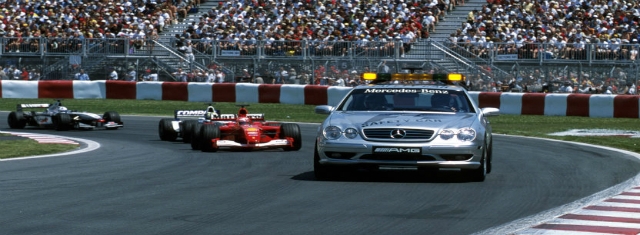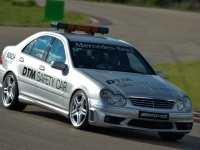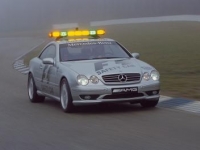Automobiles
Motorsport safety special exhibition - Safety Cars
Mercedes-Benz Museum

Mercedes-Benz Safety Car (Source: © 2015 Daimler AG. All rights reserved.)
USPA NEWS -
Mercedes-Benz Museum: Motorsport safety: special exhibition “Safety Cars“ - The "Safety Cars" special exhibition launches on 1 December 2015 at the Mercedes-Benz Museum. The exhibition in Collections Hall 5 honours the unique story of the Mercedes-Benz Safety Car.
The brand has been providing all of these special vehicles in Formula 1 since 1996. Until 17 April 2016, the exhibition will showcase a total of 14 original vehicles including DTM Safety Cars and Medical Cars. From mid-December, the exhibition will also feature a guest star: the most recent Formula 1 Safety Car, the Mercedes-AMG GT S. The elite of motorsport is fast ““ and safe. Mercedes-Benz has been contributing to this safety for two decades. Since 1996, the brand from Stuttgart has been continuously providing the Official F1â„¢ Safety Car as well as the Official F1â„¢ Medical Car. The new special exhibition at the Mercedes-Benz Museum gives an insight into a unique history.
Since the 2000 season, racing driver and Mercedes-Benz brand ambassador Bernd Mayländer has been the appointed Official F1â„¢ Safety Car driver. He is tasked with driving these extraordinary vehicles around the world's greatest race tracks. Formula 1 Safety Cars ranging from the Mercedes-Benz CL 55 AMG (C 215), released in 2000, to the Mercedes-Benz SL 63 AMG (R 230) of the 2009 season are in the spotlight of the exhibition. These vehicles are supplemented by DTM Safety Cars (German touring car masters) and Mercedes-Benz Formula 1 Medical Cars. From mid-December, the current Official F1TM Safety Car, the Mercedes-AMG GT S (C 190), which made its Formula 1 début in 2015, will be temporarily stopping off at the Atrium of the museum.
The challenges to Safety Cars in modern motorsport are vast: the vehicle is deployed in critical situations (for instance after accidents or during extremely bad weather conditions), moves to the front of the field and leads it at a safe pace for racing cars. Compared with the race pace, things may slow down during such Safety Car phases, but the average speed still lies at well over 200 km/h. The reason being that racing cars' tyres and brakes must not cool down excessively while their engines must be prevented from overheating as a result the reduced airflow.
Maximum performance for safety -
The sporty, top-of-the-line models made by Mercedes-AMG provide the required output to confidently meet these extreme requirements. Apart from additional safety and communication technology, these Mercedes-AMG high-performance sports cars have not undergone significant modifications to prepare them for their role as Safety Cars compared with their series production equivalents.
The sporty, top-of-the-line models made by Mercedes-AMG provide the required output to confidently meet these extreme requirements. Apart from additional safety and communication technology, these Mercedes-AMG high-performance sports cars have not undergone significant modifications to prepare them for their role as Safety Cars compared with their series production equivalents.
Safety Cars were only introduced as a regular feature in Formula 1 in the 1990s. Mercedes-Benz has been continuously providing the vehicles since 1996. The same applies to Formula 1 Medical Cars. These vehicles, Mercedes-AMG estates with medical emergency equipment, take emergency doctors and first aid staff to the required location within the shortest possible time. Medical Cars were introduced during the era of the FIA Formula One Safety and Medical Delegate Sid Watkins (until 2004). The neurosurgeon is regarded as the inventor of these vehicles and he has also implemented many other measures to enhance motorsport safety.
Over the past two decades, Mercedes-Benz has been contributing to significant safety improvements in international motorsport thanks to Safety Cars and Medical Cars on the basis of high-performance vehicles featuring top-of-the-range technology that is also installed in series production vehicles. For the first time, this new, special exhibition at the Mercedes-Benz Museum will be providing an overview of their unique history of innovations.
The vehicles of the "Safety Cars" exhibition at the Mercedes-Benz Museum
Official F1â„¢ Safety Cars
Mercedes-Benz CL 55 AMG (C 215), used during the 2000 season
Mercedes-Benz SL 55 AMG (R 230), used during the 2002 season
Mercedes-Benz CLK 55 AMG (C 209), used during the 2003 season
Mercedes-Benz SLK 55 AMG (R 171), used during the 2004 season
Mercedes-Benz CLK 63 AMG (C 209), used during the 2006 season
Mercedes-Benz CLK 63 AMG (C 209), used during the 2007 season
Mercedes-Benz SL 63 AMG (R 230), used during the 2008 season
Mercedes-Benz SLS AMG (C 197), used during the 2010 season
Mercedes-AMG GT S (C 190), in use since the 2015 season (temporarily on show at the Atrium)
Official F1â„¢ Safety Cars
Mercedes-Benz CL 55 AMG (C 215), used during the 2000 season
Mercedes-Benz SL 55 AMG (R 230), used during the 2002 season
Mercedes-Benz CLK 55 AMG (C 209), used during the 2003 season
Mercedes-Benz SLK 55 AMG (R 171), used during the 2004 season
Mercedes-Benz CLK 63 AMG (C 209), used during the 2006 season
Mercedes-Benz CLK 63 AMG (C 209), used during the 2007 season
Mercedes-Benz SL 63 AMG (R 230), used during the 2008 season
Mercedes-Benz SLS AMG (C 197), used during the 2010 season
Mercedes-AMG GT S (C 190), in use since the 2015 season (temporarily on show at the Atrium)
DTM Safety Cars
Mercedes-Benz SLK 32 AMG (R 170), used during the 2002 season
Mercedes-Benz C 55 AMG (W 203), used during the 2004 season
Mercedes-Benz CLK 500 (C 209), used during the 2002 season
Mercedes-Benz SLK 55 AMG (R 171), used during the 2005 season
Mercedes-Benz C 63 AMG Black Series (C 204), in use since 2012
Official F1â„¢ Medical Cars
Mercedes-Benz C 55 AMG Estate (S 203), used during the 2004 season
Mercedes-Benz C 55 AMG Estate (S 203), used during the 2005 season
Mercedes-Benz SLK 32 AMG (R 170), used during the 2002 season
Mercedes-Benz C 55 AMG (W 203), used during the 2004 season
Mercedes-Benz CLK 500 (C 209), used during the 2002 season
Mercedes-Benz SLK 55 AMG (R 171), used during the 2005 season
Mercedes-Benz C 63 AMG Black Series (C 204), in use since 2012
Official F1â„¢ Medical Cars
Mercedes-Benz C 55 AMG Estate (S 203), used during the 2004 season
Mercedes-Benz C 55 AMG Estate (S 203), used during the 2005 season
The Mercedes-Benz Museum is the only museum in the world that can document in a single continuous timeline over 125 years of auto industry history from its very beginnings to the present day.
The Mercedes-Benz Museum is open daily from Tuesday to Sunday, 9 a.m. to 6 p.m. The ticket desk always closes at 5 p.m.Registrations, reservations and the latest information: Monday to Sunday from 9 am to 6 pm at phone +49 (0)711 17-30000, by email to classic@daimler.com
The Mercedes-Benz Museum is open daily from Tuesday to Sunday, 9 a.m. to 6 p.m. The ticket desk always closes at 5 p.m.Registrations, reservations and the latest information: Monday to Sunday from 9 am to 6 pm at phone +49 (0)711 17-30000, by email to classic@daimler.com
more information: https://www.mercedes-benz.com/museum
Liability for this article lies with the author, who also holds the copyright. Editorial content from USPA may be quoted on other websites as long as the quote comprises no more than 5% of the entire text, is marked as such and the source is named (via hyperlink).











